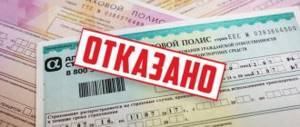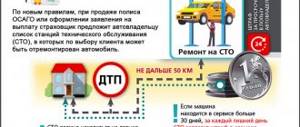On specialized Internet forums you can find many messages from users who were denied compensation for losses after an accident or were paid so little that there was not enough money for repairs. And it is no coincidence that in a number of regions the so-called auto lawyers have become more active. Directly at the scene of the accident, for a small amount they buy the victims’ rights to claim against insurers, and then sue them for many times more - along with a fine, penalties and overhead costs. And they are stung by the defeats on their clients, limiting the free sale of policies, causing “glitches” on their websites, selling additional services and reducing the amount of payments to zero. Even legislators and the Central Bank, which oversees the market, are not yet able to break this vicious circle. Therefore, car enthusiasts - especially those who cannot or do not want to get involved with car lawyers - need to know how not to be left with the “trough” broken in an accident.
Rossiyskaya Gazeta interviewed market experts and with their help compiled the top 10 tricks used by insurers to save on payments. This list will be relevant at least until the moment when in-kind compensation for damage is introduced into compulsory motor liability insurance.
Proposal to register an accident according to the European protocol
How is it happening?
The client, at the suggestion of insurance company agents who promptly arrived at the scene of the accident (and they are increasingly ahead of those same auto lawyers acting under the guise of accident commissioners), assesses the damage to his car as insignificant. In order not to wait for the traffic police officers, he decides to fill out the so-called European protocol. However, it later turns out that the repairs will cost an amount exceeding the limit of payments for such registration of an accident - 50 thousand rubles.
What to do?
Think with your own head and soberly assess the damage the car received. Some of them - especially when struck by the front of the car - can only be identified during a thorough examination.
By the way, according to lawyer Olesya Emelyanova, with a simplified registration of an accident there are other pitfalls. In particular, the literal interpretation of clause 8 of Art. 11.1 of the “Law on Compulsory Motor Liability Insurance” that the European protocol does not allow the victim to make additional demands for compensation for harm, in contrast to the usual procedure for recording an accident. “For example, an insurance company estimates a loss of 45,000 rubles at 10,000 and transfers this money to the victim. Sometimes the difference of 35,000 rubles between what was actually received and what was due is mistakenly interpreted as an additional requirement. Of course, it is not like that, but even the courts make similar mistakes,” says Emelyanova.
What to do if the insurer ignores the client after an insured event?
Does your insurance company not pay for compulsory motor liability insurance? This situation is not uncommon in our country. According to statistics, almost every second victim is not paid an insurance compensation, or the amount of payment is underestimated, and the fact that insurers do not meet the deadline provided by law is not even worth mentioning, this is almost a rule. If the insurance company has not paid under compulsory motor liability insurance, do not be upset, but begin to act immediately and decisively. Obtaining insurance compensation through the court is much more profitable. In addition to insurance, you will receive a fine of up to 50% of the collected amounts, penalties, moral damages, and also reimbursement of legal and expert fees.
Offer for “instant” payment
How is it happening?
The car owner comes to the insurance company with collected documents and unexpectedly receives an offer to “figure it out on the spot.” An employee of the company confidentially advises not to “butt heads” over the amounts and terms of payments, but to receive some kind of insurance compensation within a few minutes by signing a document on the topic “I have no more claims.”
What to do?
“Do not sign anything and do not agree to any illegal actions,” warns Evgeniy Korotaev, head of insurance business development of the Sravni.ru project. Otherwise, if the agreed amount is not enough for literally anything, you will have to blame yourself.
How to understand whether there was an understatement of payment
No matter how reliable the insurance company may seem, if we are talking about money due for payment, it is necessary to double-check all its calculations. This also applies to compensation under compulsory motor liability insurance.
Before using the repair service from the insurance company, you need to independently calculate the amount of damage caused and the estimated amount of compensation. This opportunity is available in the form of damage calculators on many websites, including the website of the Russian Union of Motorists (RUA). In addition, you can use the services of independent damage assessment experts. It is necessary to compare the data from the independent examination with the information in the documents provided by the Investigative Committee.
If the amount of payment promised by the insurance company is less than what was obtained on other resources, most likely it was underestimated.
Delay in examination
How is it happening?
In this case, the insurance company begins to play for time even earlier. Having received an application from the client with a certificate of an accident, the loss settlement department promises to inform where and when the damage assessment will be carried out. However, time passes, and there is no information about the examination. The intention is simple: an impatient car enthusiast, especially if he is losing income, may not be able to stand it and start putting the car in order. And this is a serious reason for refusing payment.
What to do?
Be patient, drive a beat-up car or take public transport. The main thing is not to send the car for repairs yourself. Moreover, the company itself knows very well that delaying payment deadlines can cost it a pretty penny. The issue must be resolved within the period specified by law - 20 calendar days, excluding holidays.
But be careful - you can fall for this trick even after an examination. “Sometimes insurers “forget” to issue a document confirming the inspection of a damaged car, and then claim that you did not provide the car for these purposes. “All this is done in order to refuse compensation,” warns the president of the ANO for the protection of the rights of policyholders “For Fair Payments,” Alexander Koval, and advises not to be shy about asking experts for an inspection report.
What documents should the insurance company issue and how to obtain them if it refuses?
Vehicle owners are required to know in what cases they are entitled to pay under compulsory motor liability insurance, and when the insurance company refuses quite legally. Such situations include cases:
- the driver injured in the accident did not take out a motor vehicle liability policy;
- the essence of client claims is compensation for moral damage;
- the expiration date of OSAGO has expired;
- violation in the procedure for registering an accident, incorrectly drawn up European protocol;
- the circumstances of the accident are questioned: whether it really happened;
- the victim refused a medical examination;
- the victim’s claim is for compensation for damage to health that arose for reasons other than the traffic accident;
- The vehicle was damaged as a result of a collision with structures, supports, buildings, cultural or architectural monuments, etc.
The rules provide for specific deadlines for payment of compensation: 20 working days are given for consideration of a general case, 30 working days for payment of compensation if the car was submitted for repairs after the approval of the insurer.
To be fair, let us remind you that illegal arguments are:
- the culprit was drunk or refused a medical examination;
- the culprit has a fake MTPL policy, is not insured, or has an expired motor vehicle license;
- the insurer of the person at fault for the accident is bankrupt or has a revoked license;
- the culprit is deprived of the right to drive a car.
In cases where the insurance company refuses to pay, you can and should act. You should not let the situation take its course, because the driver injured in the accident aims to receive compensation legally.
Based on the results of the inspection of the damaged vehicle and upon the calculation and determination of the amount of compensation, the insurance company prepares the following documents:
- vehicle inspection report for damage;
- expert opinion;
- an insured event report with calculations of the amount of damage coverage.
Representatives of the insurer are usually in no hurry to give the victim the copies of these documents he is entitled to. But you can ask to see the first two at the inspection site and take photographs yourself, at least on your phone. If this does not work out, and the insurance claim is also not issued, the documents must be officially requested.
Incorrect examination
How is it happening?
An expert authorized by the insurance company, under various pretexts, does not include certain damages in the assessment report. For example, he claims that some of the scratches or dents on the car remain from a previous accident, and “forgets” about hidden defects.
What to do?
Initially, understand that the expert is not interested in “promoting” the insurance company for large expenses, but he may well be able to help it save money. Hence the annoying misunderstandings when, instead of replacing a part, it is supposed to be repaired, and instead of repair, it is supposed to be painted.
“It is necessary to carefully inspect the car together with an expert and insist that all detected damage is reflected in the inspection report. In case of disagreement, the victim can leave his comments in the report,” recalls Andrei Likhachev, general director of the law firm.
However, in his opinion, it is necessary to worry about resolving this issue at the stage of registering the accident, making sure that the traffic police officers include in the certificate all visible damage to the car and indicate the possibility of hidden ones. By the way, about them. “When a car owner insists on examining the internal damage, the insurance company offers him to go to a service center, remove the upper parts and then call the company’s expert. Most people forget about this, and end up repairing all internal damage at their own expense,” complains Andrei Likhachev.
Photo: Alexey Malgavko / RIA Novosti.
What not to do if you want to receive payment under OSAGO
In order to receive payment under compulsory motor liability insurance from the insurance company, you must strictly follow the letter of the law and not violate the procedure prescribed after the occurrence of an accident. In this context it is not recommended:
- Eliminate malfunctions before inspection by a representative of the insurance company, recording them yourself using photos or videos and confirming them with papers about the work performed and the service station. The insurance company may regard this as a violation of the rules and refuse payments or significantly reduce them.
- Do not leave the insurance company’s consideration of the insured event to chance:
- do not completely trust the emergency inspector provided by the insurance company, since his actions are carried out solely in the interests of the employing company;
- when determining the amount of compensation by the insurance company and even after repairing the vehicle, one should not take oral information as the truth of the last instance, but demand from the service station documents on payments and from the insurance company the basis for their calculation: a vehicle inspection report and an insured event report.
- If you have doubts about the correctness of calculating the amount of compensation, do not skimp on the services of an independent expert, and if you need to go to court, do not be afraid and defend your rights.
We invite you to read: Is it possible to make a TIN at the MFC? We order and receive a TIN at the MFC
Agreement to determine the extent of damage
How is it happening?
After the examination, the insurer kindly invites the client to sign an agreement to determine the extent of damage. Only after a while does the car owner learn that, in fact, he has legalized the fact of fraud.
What to do?
As usual, carefully study any paper that requires a signature, and agree only with what you cannot but agree with. “Such a document deprives the victim of the opportunity to recover any additional amounts beyond what is established by the agreement. To do this, the document itself must be declared invalid. However, judicial practice interprets the terms of such an agreement literally: if the text is drawn up in an accessible form, then it is considered that the victim should not have any misconceptions about the consequences,” notes Olesya Emelyanova from.
Understating the amount of damage
How is it happening?
The car owner had no complaints about the examination, but then he received compensation, which was not enough to repair the car. Technical experts claim that the amounts of payments and repairs sometimes differ by 10 times.
What to do?
Try to find the "error". It could have been accepted by both the appraiser and the insurer. “Our legal service is faced with facts of underestimation in the calculations of the volume of necessary work (compared to the normative ones), as well as the allegedly accidental forgetfulness of the responsible employees of the insurers to include in the amount to be paid some details that were previously present in the defective acts agreed upon with the client. This allows insurers to lower the payment by 5-40%,” notes Andrey Barsukov, deputy general director of the Russian AutoMotoClub.
An independent audit should begin by requesting from the insurer a copy of the assessment report on the basis of which the insurance act was drawn up. “Most likely, the insurer will refuse,” suggests Alexander Koval from the ANO “For Fair Payments.” “But the law establishes that part of the insurance act is an inspection report of the damaged property and an appraiser’s report, which means that the insurer’s refusal to submit this report is illegal and punishable.”
“The car owner can conduct an independent examination to assess the damage caused to the car, and then file a claim and send it to the insurer,” recommends Dmitry Belov, director of the financial department. “The company must review the claim document and make a decision on it within five days.”
However, not everything depends on the expert. Market participants note that in the RSA price guides, according to which all calculations are made, the cost of spare parts and materials, as well as standard hours of service work, in most cases are underestimated compared to the average market values.
Procedure if the insurance company does not pay under compulsory motor liability insurance
The goal of any insurance company is to make a profit. But legislative regulation of the issuance of compulsory motor liability insurance policies and standardization of compensation amounts limit the possibilities of making money on this product. Therefore, insurance companies are trying in every possible way to save on the amount of payments for insured events. Depending on the company, these methods may or may not be legal.
Fraudulent actions in calculating the required amount are designed to ensure that the victim will not pay attention to the details of the calculation. Legal methods can be used on the basis of a not entirely correct conclusion about the damage received.
One of the reasons for legal underpayments under compulsory motor liability insurance is the lack of a unified methodology for expert examination of a vehicle after an accident. And although compensation calculations should be carried out using a unified methodology from the Central Bank, the difference in the calculation base (different results of damage assessment) directly affects the amount of payments.
While the result of damage assessment by a representative of the insurance company may depend on the following factors:
- level of access to hidden damage;
- the professionalism of the expert, his thoroughness and honesty;
- inspection conditions.
All conditions of compulsory motor insurance are regulated by Federal Law No. 40-FZ of April 25, 2002. This also applies to the issue of the amount of compensation and the reduction of their amounts. Compensation is calculated taking into account the wear and tear of spare parts and materials of the victim in an accident.
Legal grounds for reducing the amount of payments include:
- Exclusion from the estimate of costs for restoration of paintwork. This is done if the total damaged area of the vehicle is less than 25% or if there is through-through corrosion damage to the body.
- Refusal to pay for loss of commodity value, although this is a mandatory item of compensation.
- Failure to take into account the wear of replaced parts. This can reduce the cost of replacing parts by up to 50%.
If the amount received under compulsory motor liability insurance does not cover the damage and the insurance company is to blame for this, you can and should fight for your rights. Theoretically, it is possible to obtain additional compensation. Since the main legal reason for incorrect compensation calculations is inaccurate damage assessment results, the main weapon in the fight for justice will be the results of an independent expert assessment.
There are three stages on the path to receiving the desired compensation:
- Immediately after the accident, conduct an independent assessment of the damage with the involvement of a representative of the insurance company. This will immediately give you an argumentative tool to protect your rights.
- Prepare a pre-trial claim indicating the required amount of damages and justifying the correctness of its calculation with the attached opinion of an independent specialist on the results of the inspection.
- Go to court if the insurance company does not satisfy the claim.
We invite you to read: The Federal Migration Service refuses to provide documents for children
The procedure for conducting an examination after an accident is similar for both the victim and the culprit. It is important to choose a company that will carry out the examination efficiently and will not miss important points. The advantage of an assessment by an external expert is that he is not interested in underestimating the amount of damage. Therefore, his assessment can be considered objective.
The procedure for attracting an independent expert is as follows:
- find a reliable expert company or individual specialist;
- sign up for an examination;
- hold a meeting with a specialist: this can be done either at the place of future vehicle repair or by coming to a specific company;
- wait 3-5 days for the examination;
- obtain a conclusion, which must contain an assessment of damage and calculation of damages.
There are cases when the insurance company responds in writing to a client’s application about the impossibility of making compensation, arguing the reasons for the refusal and possible solutions to the problems. In all other cases, the insurance company can make a so-called unsubscribe, relying on the illiteracy of the policyholder and his inexperience.
From the point of view of the law “On Compulsory Motor Liability Insurance”, the insurance company is obliged to give the client a written response to his request within 10 working days. But, as mentioned above, only a small part of the IC acts in this way.
The same regulatory legal act also states that in the event of insufficient documents, the Investigative Committee is obliged to provide a complete list of missing papers and inaccuracies in their execution within 3 working days in writing by mail or by direct contact to the victim. At the request of the victim, the Investigative Committee is obliged to accept electronic copies of the missing documents.
Within a period not exceeding 5 working days from the date of submission of the application, the insurance company is obliged to inspect the car, agree on and sign the report.
If the policyholder disagrees, the company is obliged to organize an independent technical examination to identify discrepancies in the payment amount.
The responsibilities of the insurance company are described in more detail in Article 12 of Federal Law No. 40 (Procedure for the implementation of insurance compensation for harm caused to the victim). Violation of this provision by the insurer becomes a reason for appealing to higher authorities.
A pre-trial claim is a document that resolves most disputes with the insurance company. Sometimes even a complaint addressed to the head of the Investigative Committee helps solve the problem, but pre-trial proceedings are a more powerful “argument” on the part of the injured driver.
The advantages of such a solution eliminate the need to pay court fees, lawyer services or legal consultations, and waste time on all sorts of hassles.
If you do not agree with the actions of the insurer and the amount of compensation for the loss, then you must first file a claim. The law obliges insurers to respond within 10 business days.
Any person can file a pre-trial claim: a citizen of the Russian Federation, a foreigner, a legal entity or an individual. Some insurance companies even have special forms for preparing this document. If you have doubts about the correctness of the registration, it makes sense to seek advice from a lawyer.
Pre-trial claim to the insurance company under MTPL Pre-trial claim. Page 2
Expert opinion
Mironova Anna Sergeevna
Lawyer and lawyer for automobile law. Specializes in administrative and civil law, insurance.
Receipt of payment directly depends on the competence of drawing up a pre-trial claim. Therefore, it should contain references to laws, arguments and justifications for the rightness of the victim.
The document can be written in free form, but all the necessary information must be presented there:
- FULL NAME. IC client, his passport details, address, contact phone number;
- for legal entities, it is necessary to indicate the form of ownership, legal name, legal address and telephone number, as well as details of the responsible person;
- name of the insurance company where the pre-trial claim is filed, physical and legal address;
- an explanation of the situation that resulted in the conflict;
- essence of the claim: non-payment of the insured amount, insufficient payment, delay, etc.
- the explanation must contain references to unfulfilled clauses of the contract indicating the article of law that this or that clause regulates;
- requirements indicating the amount of payment.
We invite you to read: Irregular working hours: who is entitled to it and what are the features in 2021
The following package of documents must be attached to the pre-trial claim:
- A copy of the policyholder's civil passport.
- Copies of PTS or STS.
- OSAGO insurance policy.
- Certificate from the traffic police about a traffic accident.
- Medical certificate if there is damage to health.
- Death certificate, if there are dead.
- Conclusion of an independent examination in case of underestimation of payments.
- Payment documents confirming other expenses, such as postal, ambulance, tow truck, etc.
Within 10 working days, the insurance company is obliged to respond to the pre-trial claim, and this must be either a payment made or a written refusal.
Complaint to RSA
The Russian Union of Auto Insurers or RSA is a public organization that monitors the quality of insurance services and the proper execution of compensation payments.
By contacting the RSA or the Central Bank of the Russian Federation, the client of the insurance company can solve the problem pre-trial, or can file a complaint after the claim is rejected.
You can send a complaint through the official website of the RSA, attaching all the documents and photos necessary to confirm your claim.
The cases when it is reasonable to contact the RSA are the same:
- Insurance company does not pay damages after an accident;
- delays payment deadlines;
- compensation has not been paid in full;
- illegally recognizes the case as uninsurable;
- canceled the KBM, and many other situations.
You can contact us by phone:
- 7(495) 641-27-85 – In Moscow;
- 8-800-200-22-75 – Hotline for all regions of the Russian Federation.
The claim is drawn up in paper form, similar to the pre-trial one, and all the same documents are attached to it. You can send it by mail to the address: 115093, Moscow, st. Lyusinovskaya, 27, building 3.
Payment delay
How is it happening?
After the occurrence of an insured event, the car owner collected and submitted all the necessary documents to the company, passed an examination to assess the damage, but the insurer simply delays payment.
What to do?
To begin with, read the insurance rules either in the brochure that should have been issued upon concluding the contract, or on the company’s website. The document clearly states all the regulations, including payment deadlines. Once you are convinced that the insurance company is violating them by not responding to the client’s legitimate demands, you must begin to act.
“You can write a complaint to the Central Bank and the Russian Union of Auto Insurers (RUA), advises Alexander Koval. — If you couldn’t get a clear answer from there, write a pre-trial claim to the insurance company. It can be sent by registered mail with return receipt requested or submitted through a secretary with a note of acceptance. The claim must ask for a written explanation of the reason for the delay and demand payment. If the company has not responded, it is worth going to court and seeking insurance compensation, as well as penalties or interest for the delay in payment.”
Photo: Maxim Bogodvid / RIA Novosti.
Pre-trial settlement
If, based on the results of an inspection by an independent expert, it is obvious that the insurance company has underestimated the payment, the first step is to file a claim.
Submitting a claim to the Investigative Committee does not mean that it will be satisfied. But in the future it can be used as an attachment to a lawsuit.
It is better to draw up this document with the help of a lawyer. The claim must include the following information:
- last name, first name and patronymic of the victim;
- applicant's passport details;
- name of the recipient company;
- complete legal information about the insurance company;
- the essence of the problem and reasoned justification of the requirements;
- bank account details for transferring the missing amount if the request is satisfied.
It is also important to add a clause stating that in case of refusal to satisfy the request, a lawsuit will follow and the insurance company will have to pay a fine, penalties, technical assistance and the services of an independent expert.
The following documents must be attached to the pre-trial claim:
- applicant's passport;
- OSAGO policy;
- vehicle document;
- certificate of accident;
- expert opinion.
You can submit such a claim in the following ways:
- sending by mail with a certified letter with acknowledgment of delivery
- transfer of insurance to the employee against signature directly in the office.
If there is a confirmed fact that the insurance company underpaid compensation to the victim, then most likely he is not alone. At a minimum, to improve the work of the insurance company, it makes sense to file complaints against it in connection with such violations to the regulatory authorities: RSA and FSSN.
But such appeals are not able to directly influence the decision on a specific problem; they can only provoke an audit of the company’s work by these organizations.
You can obtain information and find the appropriate forms for a complaint to the RSA at this link.
The car damaged in the accident was considered completely destroyed and was subject to disposal. Valid leftovers were not used. The plaintiff demanded full compensation, but refused to give them to the insurer, on the basis of which he was refused compensation.
The court ruled that based on Art. 15. According to the Civil Code of the Russian Federation, real damage is determined taking into account the part that the plaintiff continues to use, so the insurance company was obliged to make a payment without taking into account the cost of the usable balances.
Claims regarding an injured customer's policy
How is it happening?
At some point, the insurance company refuses to pay compensation to the client, citing the fact that he has an invalid or even fake policy. It is worth mentioning that until recently it was much easier to purchase “strange” insurance than genuine insurance without queues and additional encumbrances.
What to do?
“Don’t give up, thinking that only you are to blame for purchasing a counterfeit,” even if there is one, reminds Alina Tukhvatullina, a lawyer at the FreshDoc.ru Document Constructor service. According to her, you should find the receipt for the purchase of the policy and all other documents drawn up when the document was issued, as well as initiate correspondence with the insurance company, if, of course, it was conducted. By the way, experts advise communicating with insurers in writing, and better yet, by regular mail, keeping the envelopes and attachments. And the main thing is to remember: it is the insurer who needs to prove the guilt of the car owner, and not the client who needs to look for excuses.
As an example, it is worth citing the recent consideration of a case in the Kemerovo region - about the insurer’s refusal to pay compensation due to, in its opinion, the insured’s policy being counterfeit. The lawyer called the summary of the judicial act “comforting” for motorists: “The law does not impose on the policyholder the obligation, when concluding a contract, to check the legality of the insurance company’s possession of the policy form; the policyholder who paid the insurance premium and received the policy form without obvious signs of falsification, in this case should not be responsible for certain actions of the insurer’s representative or third parties.”
“In general, this practice is based on the position of the Supreme Court of the Russian Federation, which, in its Resolution dated January 29, 2015, emphasized that the issuance of an insurance policy is evidence confirming the conclusion of a compulsory motor liability insurance agreement until otherwise is proven,” notes Alina Tukhvatullina.
“The problem is not only with real fakes, but also with the dishonesty of some insurers, who after an official sale (often right in their office) after some time declare this policy lost,” explains Andrey Barsukov from Russian AutoMotoClub. And he advises to insure only with time-tested insurers who are familiar to car owners: “Never agree to purchase a policy anywhere at a reduced price - everyone’s rates are almost the same, the price difference is possible by no more than 10-15%.”
Appeal to problems with the policy of the person responsible for the accident
How is it happening?
Lawyers call this “refusal of direct compensation for loss due to lack of acceptance (confirmation of availability) of a valid insurance policy. The solution to the problem is to submit documents to the court and request to the RSA on the fact of concluding an insurance contract with the culprit of the accident. If the insurer refused on the basis of “non-payment by the agent of money from the transaction under the policy sold,” but the policy owner has a receipt for payment, then these are internal problems of the insurer in accounting and control of payment, which do not concern the buyer of the service. It’s another matter if payment is refused because the policy turned out to be fake. Then you will have to sue not the company, but directly the owner of this policy,” emphasizes Evgeniy Korotaev from Sravni.ru.










